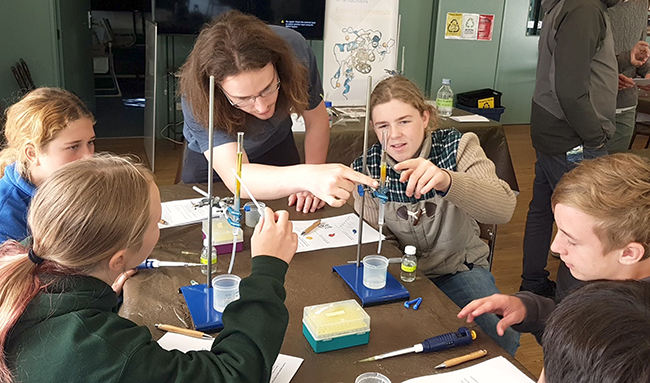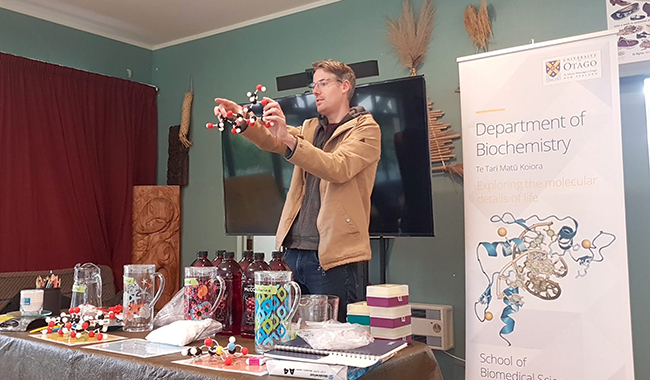Tuesday 4 April 2023 10:17am
How do you find just one molecule out of the thousands in every cell? Rangatahi Māori (Māori youth) from across Ōtepoti Dunedin found out how they can separate out molecules at 'Tuia i Hawaiki, tuia i te Uru - Science Wānanga' held recently at the Araiteuru Marae.

PhD student Josh Scadden and rangatahi Māori watch molecules being separated in chromatography column.
'Tuia i Hawaiki, tuia i te Uru – Science Wānanga' was established in 2007 in collaboration with the late Dr Paratene Ngata (Ngāti Porou). It started in Ngāti Porou and has flourished all over Aotearoa connecting and collaborating with many tribal, social and educational groups such as iwi, rūnanga, hapū, marae and kura. The Wānanga is a 3-day noho (residential) marae for rangatahi Māori in school years 7-10 where they engage in fun hands-on and relevant pūtaiao (science) in their rohe (region). Tikanga Māori (Māori customs) are embedded throughout the Kaupapa (programme) as it is held on marae and with mana whenua.
Thirty one students and a handful of teachers from high schools across Ōtepoti took part alongside attendees from the university. Science Wānanga are supported through partnerships between iwi, schools and the University of Otago Divisions of Sciences.
Everyone took part in the pōwhiri followed by a round of mihimihi (greetings) allowing everyone to make connections with one another as pepeha (introductions) were recited.
Then groups of students rotated around different activities for the next two days, exploring the worlds of biochemistry, physics, neuroscience and chemistry.
Representing te Tari Matū Koiora (the Biochemistry Department) were teaching fellow Ben Peters, lecturers and research group leaders Peter Mace and Nathan Kenny, comms and outreach coordinator Miriam Sharpe and PhD student Josh Scadden, who all took turns to lead lessons and guide activities from the floor.
Rangatahi not only found out how to separate molecules using chromatography columns, but also found out how taste receptors work and had a go at building models of biological molecules.
Ben, Peter and Nathan had the full experience and stayed overnight with the SW team and kura, in the wharenui (main meeting house area).
Miriam said, “It was an honour to contribute to the Wānanga. The kids were really keen to learn more, and we learned a lot from them too. Ka mau te wehi!”
You can find out more about Science Wānanga here on the University website.
Ngā mihi nui (thank you very much) to everyone involved, particularly Mariana Te Pou who does an amazing job of leading the Science Wānanga initiative at the University of Otago.

Teaching fellow Ben Peters explains how we taste sugar molecules to rangatahi.